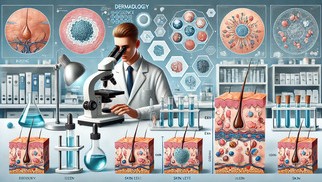Skin Infections Caused by Susceptible Pathogens: Causes, Types, and Treatment


Skin infections are a common yet diverse set of conditions caused by microorganisms such as bacteria, fungi, viruses, and parasites. While the skin acts as a protective barrier for our body, it is also susceptible to various infections when compromised. Understanding the causes, types, and treatment of skin infections is essential for proper management and prevention. In this article, we will explore the pathogens responsible for these infections, the common types of skin infections, reasons for susceptibility, and the role of treatments like Bactroban in managing bacterial skin infections.
What Pathogen Causes Skin Infections?
Skin infections can be caused by several types of pathogens, depending on the source of infection and the state of the individual’s immune system. These include:
- Bacteria: The most common culprits of bacterial skin infections are Staphylococcus aureus (including methicillin-resistant strains like MRSA) and Streptococcus pyogenes. These bacteria can invade the skin through cuts, abrasions, or compromised skin barriers.
- Fungi: Dermatophytes, such as Trichophyton species, are responsible for fungal skin infections like athlete’s foot and ringworm. Candida species can also cause infections, especially in warm and moist skin folds.
- Viruses: Skin infections caused by viruses include warts (caused by human papillomavirus) and herpes simplex virus (responsible for cold sores and genital herpes).
- Parasites: Scabies (caused by Sarcoptes scabiei) and lice infestations are examples of parasitic skin infections.
Each pathogen exploits different vulnerabilities of the skin, often causing distinct symptoms and requiring targeted treatment.
What Are the Five Types of Skin Infections?
Skin infections are classified based on the nature of the pathogen and the depth of tissue involvement. Here are five major types:
- Bacterial Skin Infections These infections include impetigo, cellulitis, erysipelas, folliculitis, and abscesses. Bacterial infections are often marked by redness, swelling, warmth, and pain. They can escalate quickly, making early diagnosis and treatment crucial.
- Fungal Skin Infections Fungal infections such as athlete's foot, ringworm, and jock itch are common in moist and warm environments. Symptoms often include itching, redness, and scaling of the skin.
- Viral Skin Infections Conditions like warts, shingles, and herpes simplex virus infections are viral in origin. They may present as blisters, lesions, or crusted areas on the skin.
- Parasitic Skin Infections Scabies and lice infestations cause intense itching and discomfort. These infections are contagious and can spread rapidly in crowded environments.
- Mixed or Opportunistic Infections In individuals with weakened immune systems, skin infections may be caused by a combination of pathogens, including opportunistic bacteria and fungi. Examples include infections in diabetic foot ulcers and bedsores.
What Is the Most Common Pathogen to Cause a Skin Wound Infection?
The most common pathogen responsible for skin wound infections is Staphylococcus aureus. This bacterium, which is naturally present on the skin and in the nasal passages of many individuals, becomes pathogenic when it enters a wound or disrupted skin barrier.
In some cases, strains of Staphylococcus aureus can exhibit resistance to common antibiotics, leading to methicillin-resistant Staphylococcus aureus (MRSA) infections. These infections are particularly challenging to treat and may require specialized antibiotics or topical therapies like Bactroban (mupirocin).
What Opportunistic Pathogenic Bacteria Is Associated with Skin?
Opportunistic pathogens are microorganisms that typically do not cause harm but can lead to infections when the body’s immune defenses are weakened. For the skin, opportunistic pathogens include:
- Pseudomonas aeruginosa: Frequently found in hospital settings, this bacterium can cause infections in burn wounds, surgical sites, and areas of broken skin. It thrives in moist environments, such as improperly cleaned whirlpools and pools.
- Acinetobacter species: These bacteria are associated with hospital-acquired infections and can infect open wounds or ulcers.
- Candida species: Although primarily a fungal pathogen, Candida albicans can act opportunistically, especially in individuals with weakened immune systems or diabetes.
Opportunistic infections often arise in individuals with underlying conditions such as diabetes, HIV/AIDS, or in those undergoing chemotherapy or taking immunosuppressive medications.
Why Am I Susceptible to Skin Infections?
Several factors can increase your susceptibility to skin infections, including:
- Compromised Skin Integrity: Any break in the skin, such as cuts, scrapes, or surgical wounds, provides an entry point for pathogens.
- Weakened Immune System: Chronic conditions like diabetes, HIV, or cancer weaken the immune response, making it harder for the body to fight off infections.
- Poor Hygiene: Inadequate personal hygiene can increase the risk of skin infections, especially in communal settings like gyms or schools.
- Environmental Factors: Warm, humid conditions encourage the growth of fungi and bacteria, while overcrowded living conditions can promote the spread of contagious infections.
- Medical Devices or Procedures: Catheters, intravenous lines, and surgical procedures can introduce pathogens into the skin and underlying tissues.
- Underlying Skin Conditions: Pre-existing skin conditions like eczema, psoriasis, or acne can compromise the skin barrier and predispose individuals to infections.
Treatment of Skin Infections with Bactroban
Bactroban, which contains the active ingredient mupirocin, is a widely used topical antibiotic for treating bacterial skin infections. It is particularly effective against Staphylococcus aureus (including MRSA) and Streptococcus pyogenes. Here’s how Bactroban is used in the management of skin infections:
Mechanism of Action: Mupirocin works by inhibiting bacterial protein synthesis, leading to the death of the bacteria. Its targeted action ensures effective treatment without disrupting the natural skin microbiome significantly.
Indications: Bactroban is commonly prescribed for:
- Impetigo: A superficial bacterial infection often seen in children.
- Infected cuts, abrasions, or minor wounds.
- Nasal decolonization of MRSA in certain cases.
Application: Bactroban is applied directly to the affected area as a thin layer. It is typically used 2-3 times a day for up to 10 days or as directed by a healthcare provider. The area may be covered with a sterile dressing if needed.
Efficacy: Clinical studies have shown Bactroban to be highly effective in clearing bacterial infections, often leading to rapid improvement in symptoms like redness, pain, and swelling.
Safety and Side Effects: Bactroban is generally well-tolerated, with minimal side effects such as mild burning or stinging at the application site. However, it should not be used for extended periods or on large areas of broken skin without medical supervision, as this may promote antibiotic resistance.
Preventing Skin Infections
While treatments like Bactroban are effective, prevention remains key. Basic measures include maintaining good hygiene, promptly cleaning and covering wounds, avoiding sharing personal items, and addressing underlying health conditions that weaken the immune system. In healthcare settings, strict adherence to infection control protocols can prevent the spread of opportunistic and resistant pathogens like MRSA.
Conclusion
Skin infections caused by susceptible pathogens range from mild, superficial conditions to severe, life-threatening diseases. Understanding the causative pathogens, types of infections, and factors that increase susceptibility is crucial for effective prevention and treatment. For bacterial skin infections, Bactroban provides a reliable and targeted solution, especially for infections caused by Staphylococcus aureus and Streptococcus pyogenes. If you are prone to recurrent or severe skin infections, consulting a healthcare professional is essential for proper diagnosis and management. By combining effective treatments with preventive measures, it is possible to reduce the burden of skin infections and maintain healthy skin.
Medically Reviewed by Dr. Mevan Nandaka Wijetunga, MD
(Updated at Jan 26 / 2025)